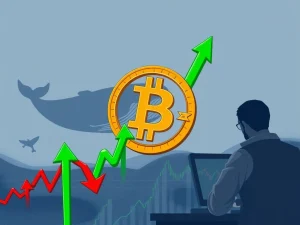Bitcoin Price Shows Remarkable Resilience Amid Geopolitical Turmoil

In a world often shaken by geopolitical instability, how does the leading cryptocurrency, Bitcoin, truly react? Recent events suggest a surprising degree of resilience. Despite escalating regional conflicts, the Bitcoin price has demonstrated stability and, at times, even rallied. This behavior contrasts with traditional risk assets and warrants a closer look, especially as the crypto market matures and attracts more institutional players.
Bitcoin Price Holds Steady Amid Regional Conflicts
Over the past decade, Bitcoin’s price has faced numerous global flashpoints. Historically, its reaction to war and armed conflict has often been one of resilience. While traditional markets might experience immediate downturns, Bitcoin has frequently recovered quickly or remained relatively unaffected. This trend continues to be observed, even in recent conflicts.
Analysts have differing views on Bitcoin’s short-term reaction. Some, like André Dragosch from ETC Group, note that Bitcoin, still perceived as a risky asset by many, can see sell-offs immediately following conflict outbreaks. However, the underlying volatility of BTC is generally decreasing over time. Longer-term perspectives, such as those shared by Mithil Thakore of Velar, suggest that geopolitical events can lead to factors like increased inflation, which could ultimately benefit Bitcoin.
Examining specific geopolitical events provides valuable insight into Bitcoin’s historical reactions:
- **Israel-Iran War (June 2025):** Following significant strikes, Bitcoin saw a brief dip but quickly recovered, largely shrugging off concerns despite calls for wider escalation.
- **Israel-Iran Embassy Bombing (April 2024):** After attacks and retaliations, Bitcoin experienced a temporary downward movement, losing over 8% post-April 13th. However, as markets adjusted, Bitcoin resumed its upward trajectory.
- **Israel-Gaza War (Oct 2023):** This conflict saw Israeli markets suffer losses, but Bitcoin remained largely unaffected and performed well in the following weeks.
- **Russia’s Full-Scale Invasion of Ukraine (Feb 2022):** Contrary to expectations, Bitcoin’s price spiked upward, rising 16% in the first five days. Crypto trading saw premiums in affected regions as people used digital assets to navigate currency controls.
Geopolitical Events and Shifting Market Dynamics
While Bitcoin has shown resilience to major international conflicts, its reaction to internal conflicts, particularly those less connected to Western traditional markets, has been minimal. Events like the Tigray war in Ethiopia (2020) or the Myanmar civil war (2021) coincided with significant Bitcoin bull runs driven by other factors like inflation concerns and growing institutional adoption, rather than reacting to the conflicts themselves.
A key factor influencing Bitcoin’s response to geopolitical events is its increasing exposure to traditional financial markets. This correlation is a relatively new phenomenon.
Consider Bitcoin’s early years (around 2013-2014):
- Bitcoin was a niche asset.
- Mining was accessible with consumer hardware.
- Exchanges like Kraken and Coinbase were very young.
- Institutional involvement was virtually nonexistent.
- The asset was often dismissed or associated with illicit activity.
During conflicts like the 2014 Donbas war or the 2014 Gaza war, while stock markets reacted, there was little discussion in the nascent crypto media about the wars’ effect on Bitcoin price. The asset operated largely outside the traditional financial system’s immediate concerns.
The Impact of Institutional Adoption on Bitcoin Price
The landscape has dramatically changed. Institutional adoption is now a significant driver of the crypto market, particularly for Bitcoin. As of late 2024, a substantial percentage of Bitcoin is held by entities like ETF issuers (BlackRock, etc.), regulated exchanges (Kraken, Coinbase), and even governments (US government). This concentrated ownership among Western institutions fundamentally alters Bitcoin’s market behavior.
This paradigm shift means Bitcoin has greater exposure to traditional financial markets than ever before. The narrative is evolving from purely a risk-off, uncorrelated asset to one with increasing correlation to broader market sentiment, which *is* affected by geopolitical events. While it still shows resilience compared to some assets, its reactions are becoming more complex and potentially more aligned with traditional risk assets during times of severe global tension.
Understanding Bitcoin’s Place in the Current Crypto Market
Despite the increasing correlation due to institutional adoption, analysts remain cautiously optimistic. Severe escalations in regional conflicts could still impact global risk assets, potentially influencing Bitcoin. However, the historical data shows a consistent pattern of quick recovery or even positive movement following initial shocks.
Bitcoin’s reaction to regional conflicts is evolving. While past events demonstrated a remarkable ability to shrug off global turmoil, the increasing integration with traditional finance through institutional adoption means its future responses may be more nuanced. It remains a fascinating asset to watch during times of geopolitical uncertainty, balancing its original decentralized ethos with its growing role in the mainstream financial world.
In conclusion, Bitcoin has historically shown resilience during regional conflicts, often recovering quickly from initial dips. However, the significant increase in institutional adoption is changing its market dynamics, potentially leading to greater correlation with traditional finance. While it may still offer unique characteristics during global tension, its future reactions will likely be a blend of historical resilience and new market influences.









